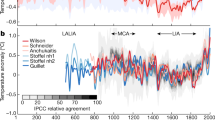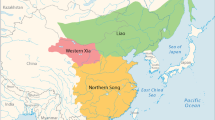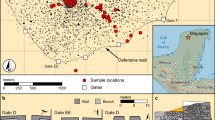Abstract
Climate change, population growth and extreme events can trigger social crises and instability. The processes that dominate a society’s emergence, resilience and collapse, and the complex interactions among such processes, operating within a small region, at a multicentury or even larger time scale, remain to be identified. The causes or driving forces responsible for societal changes must be identified for a plausible explanation. Historical records provide unique examples of societies that have failed to develop buffers and strategic resilience against climate change and natural variability. Using a wide range of observations from China’s Hexi Corridor, the complex interactive processes linking climate change with human society over the past two millennia were investigated. This paper proposes a domino effect resulting from a society’s failure to respond to climate change in which individual small problems create a greater challenge over long time spans. Building resilience against the impacts of climate change requires a deep understanding of social and environmental feedbacks to create a reliable buffer against future changes. This study offers lessons learned from the past 2,000 years that remain relevant today, given the projected changes in climate and extreme events.
This is a preview of subscription content, access via your institution
Access options
Access Nature and 54 other Nature Portfolio journals
Get Nature+, our best-value online-access subscription
$29.99 / 30 days
cancel any time
Subscribe to this journal
Receive 12 digital issues and online access to articles
$119.00 per year
only $9.92 per issue
Buy this article
- Purchase on Springer Link
- Instant access to full article PDF
Prices may be subject to local taxes which are calculated during checkout



Similar content being viewed by others
Data availability
The data on climate change, biological productivity and socioeconomy that support the findings of this study are available from the corresponding author on reasonable request.
Code availability
The source codes of the Granger causality and regression analysis used in this study can be obtained from the corresponding author on reasonable request.
References
Hsiang, S. M. & Meng, K. C. Reconciling disagreement over climate–conflict results in Africa. Proc. Natl Acad. Sci. USA 111, 2100–2103 (2014).
Hsiang, S. M., Meng, K. C. & Cane, M. A. Civil conflicts are associated with the global climate. Nature 476, 438–441 (2011).
McMichael, A. J. Insights from past millennia into climatic impacts on human health and survival. Proc. Natl Acad. Sci. USA 109, 4730–4737 (2012).
Zhang, P. Z. et al. A test of climate, sun, and culture relationships from an 1810-year Chinese cave record. Science 322, 940–942 (2008).
Büntgen, U. et al. 2500 years of European climate variability and human susceptibility. Science 331, 578–582 (2011).
Zhang, D. D., Brecke, P., Lee, H. F., He, Y. Q. & Zhang, J. Global climate change, war, and population decline in recent human history. Proc. Natl Acad. Sci. USA 104, 19214–19219 (2007).
Carleton, T. A. & Hsiang, S. M. Social and economic impacts of climate. Science 353, aad9837 (2016).
Burke, M. B., Miguel, E., Satyanath, S., Dykema, J. A. & Lobell, D. B. Warming increases the risk of civil war in Africa. Proc. Natl Acad. Sci. USA 106, 20670–20674 (2009).
Weiss, H. & Bradley, R. S. What drives societal collapse? Science 291, 609–610 (2001).
Yin, J., Su, Y. & Fang, X. Climate change and social vicissitudes in China over the past two millennia. Quat. Res. 86, 133–143 (2016).
Ge, Q. S., Hao, Z., Zheng, J. & Shao, X. Temperature changes over the past 2000 yr in China and comparison with the Northern Hemisphere. Clim. Past 9, 1153–1160 (2013).
Butzer, K. W. & Endfield, G. H. Critical perspectives on historical collapse. Proc. Natl Acad. Sci. USA 109, 3628–3631 (2012).
Rosen, A. M. & Rivera-Collazo, I. Climate change, adaptive cycles, and the persistence of foraging economies during the late Pleistocene/Holocene transition in the Levant. Proc. Natl Acad. Sci. USA 109, 3640–3645 (2012).
Butzer, K. W. Collapse, environment, and society. Proc. Natl Acad. Sci. USA 109, 3632–3639 (2012).
Lee, H. F. & Zhang, D. D. Changes in climate and secular population cycles in China, 1000 CE to 1911. Clim. Res. 42, 235–246 (2010).
Piao, S. L. et al. The impacts of climate change on water resources and agriculture in China. Nature 467, 43–51 (2010).
Scheffran, J., Brzoska, M., Kominek, J., Link, P. M. & Schilling, J. Climate change and violent conflict. Science 336, 869–871 (2012).
Yang, L. et al. Identifying separate impacts of climate and land use/cover change on hydrological process in upper stream of Heihe River, Northwest China. Hydrol. Process. 31, 1100–1112 (2017).
Zhu, L. et al. Climate change on the Tibetan Plateau in response to shifting atmospheric circulation since the LGM. Sci. Rep. 5, 13318 (2015).
Zhang, Y., Fu, G., Sun, B., Zhang, S. & Men, B. Simulation and classification of the impacts of projected climate change on flow regimes in the arid Hexi Corridor of Northwest China. J. Geophys. Res. 120, 7429–7453 (2015).
Pei, Q. & Zhang, D. D. Long-term relationship between climate change and nomadic migration in historical China. Ecol. Soc. 19, 68 (2014).
Pei, Q., Zhang, D. D. & Lee, F. Evaluating the effectiveness of agricultural adaptation to climate change in preindustrial society. Asian Geographer 32, 85–98 (2015).
Akaike, H. A new look at the statistical model identification. IEEE Trans. Autom. Control 19, 716–723 (1974).
Huning, L. & AghaKouchak, A. Mountain snowpack response to different levels of warming. Proc. Natl Acad. Sci. USA 115, 10932–10937 (2018).
Zhang, D. D. et al. The causality analysis of climate change and large-scale human crisis. Proc. Natl Acad. Sci. USA 108, 17296–17301 (2011).
Malthus T. R. An Essay on the Principle of Population and a Summary View of the Principle of Population (ed. Flew, A.) 114–115 (Penguin, 1970).
Santayana, G. The Life of Reason Vol. 2, 334–340 (Dover Publications, 1906).
Diamond, J. M. Collapse: how societies choose to fail or survive. Reis 13, 249–250 (2005).
Acheson, J. M. Institutional failure in resource management. Ann. Rev. Anthropol. 35, 117–134 (2008).
Kiem, A. S. & Austin, E. K. Drought and the future of rural communities: opportunities and challenges for climate change adaptation in regional Victoria, Australia. Glob. Environ. Change 23, 1307–1316 (2013).
Crutzen, P. J. Geology of mankind. Nature 415, 23 (2002).
Barnosky, A. D. et al. Merging paleobiology with conservation biology to guide the future of terrestrial ecosystems. Science 355, aah4787 (2017).
IPCC Climate Change 2014: Synthesis Report (eds Core Writing Team, Pachauri, R. K. & Meyer L. A.) (IPCC, 2014).
Ju, H., van der Velde, M., Lin, E., Xiong, W. & Li, Y. The impacts of climate change on agricultural production systems in China. Clim. Change 120, 313–324 (2013).
Hsiang, S. M., Burke, M. & Miguel, E. Quantifying the influence of climate on human conflict. Science 341, 1235367 (2013).
Granger, C. W. J. Some recent development in a concept of causality. J. Econometr. 39, 199–211 (1988).
Acknowledgements
This work was supported by the National Key R&D Program of China (grant no. 2017YFC0404305), the Major Program of the Natural Science Foundation of Gansu province, China (grant no. 18JR4RA002) and CAS ‘Light of West China’ Program. We thank G. Hart of Montréal, Canada, for his help in writing this paper.
Author information
Authors and Affiliations
Contributions
Q.F. and L.Y. designed and performed the research. Q.F., L.Y., Z.Y., J.S., X.W., M.Z. and R.C.D. analysed the data. Q.F., L.Y., W.L., A.A., J.F.A., R.S. and S.C. wrote the paper. L.Y., R.C.D. and Z.Y. prepared the figures. All authors reviewed the manuscript and approved it for submission.
Corresponding authors
Ethics declarations
Competing interests
The authors declare no competing interests.
Additional information
Publisher’s note Springer Nature remains neutral with regard to jurisdictional claims in published maps and institutional affiliations.
Supplementary information
Supplementary Information
Supplementary Figs. 1–9 and Tables 1–4.
Rights and permissions
About this article
Cite this article
Feng, Q., Yang, L., Deo, R.C. et al. Domino effect of climate change over two millennia in ancient China’s Hexi Corridor. Nat Sustain 2, 957–961 (2019). https://doi.org/10.1038/s41893-019-0397-9
Received:
Accepted:
Published:
Issue Date:
DOI: https://doi.org/10.1038/s41893-019-0397-9
This article is cited by
-
How Can Governments Be Motivated to Stably and Ethically Govern a Country? Lessons Learned from China
Journal of the Knowledge Economy (2024)
-
Stocks of soil carbon, nitrogen, and phosphorus in coniferous forests on the Qilian Mountains: spatial trends and drivers
European Journal of Forest Research (2023)
-
Potential effects of oasis expansion on ecosystem service value in a typical inland river basin of northwest China
Environmental Science and Pollution Research (2023)
-
Temperature variations along the Silk Road over the past 2000 years: Integration and perspectives
Science China Earth Sciences (2023)
-
Human settlements in the Ordos Plateau since the Neolithic Age
Journal of Geographical Sciences (2023)



